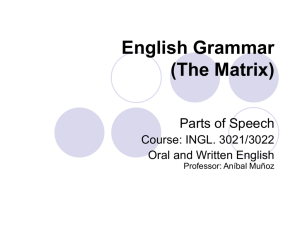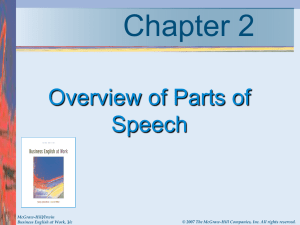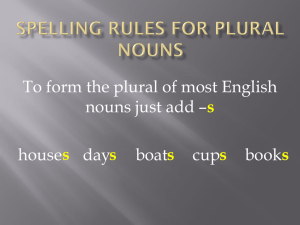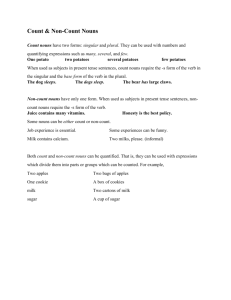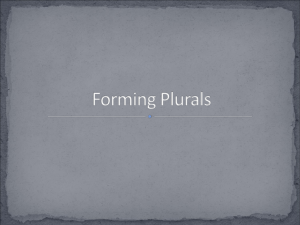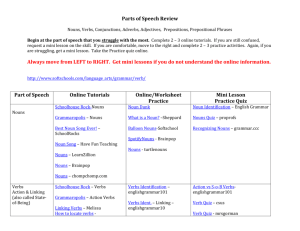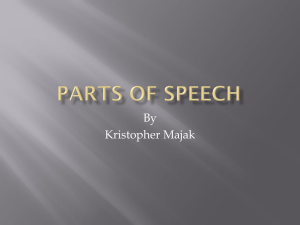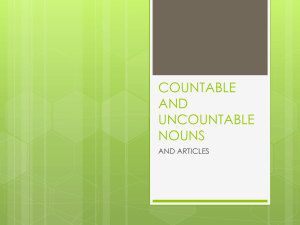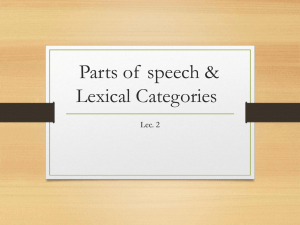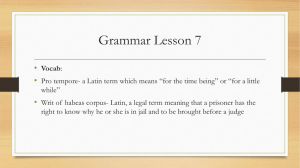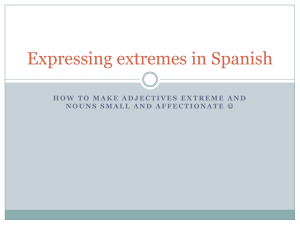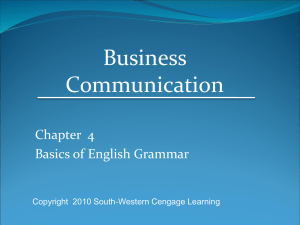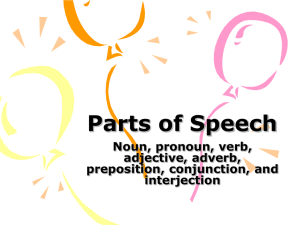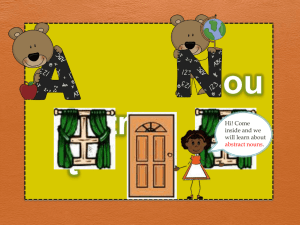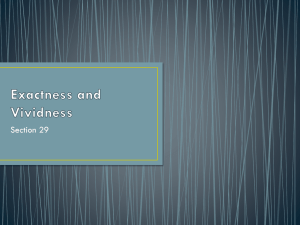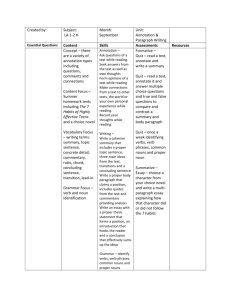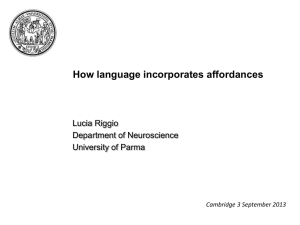English Grammar (The Matrix)
advertisement
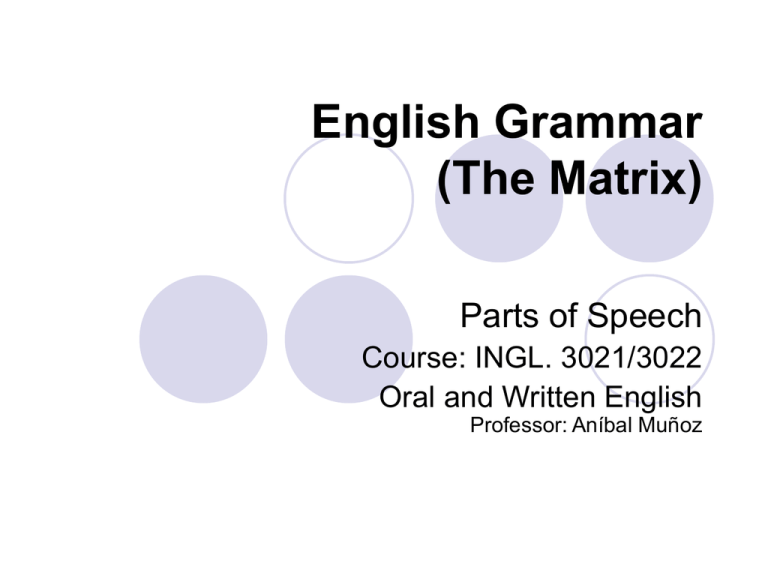
English Grammar (The Matrix) Parts of Speech Course: INGL. 3021/3022 Oral and Written English Professor: Aníbal Muñoz Preview Definitions Nouns Pronouns Verbs Adjectives Adverbs Prepositions Conjunctions Interjections Determiners Subordinators Interrogatives Qualifiers Sentence combinations Yes/no questions Information questions Punctuation rules Capitalization rules Grammar definition The grammar of a language is a complex of systems that may be analyzed and studied on these three levels: (Noam Chomsky’s UG) 1. Phonology (set of sounds/ symbols) 2. Morphology (combinations of sounds that carry single units of meaning) 3. Syntax (how single units of meaning are combined to form words, phrases and sentences. Parts of speech (Nouns) Nouns 1. 2. 3. 4. Definition Proper / common Singular / plural (annex) Count / non-count /abstract (annex) (how much –how many) 5. Collectible (group nouns) 6. Units of measurement (Reference: Schramper Azar, Betty,1996. Basic English Grammar) Definition (proper and common nouns) Nouns – words used to name a person, place, thing, object, quality, idea, concept, or an action. a country Puerto Rico A person Carlos Ryder Hospital Ref. (American Heritage Dictionary, 2001) Proper Nouns- special or particular name given to common nouns to distinguish them from others of the same kind. Example: common- woman proper Martha a pet Puppy a place Proper Nouns many others a day Monday a monument The Statue of Liberty Proper and common nouns COMMON PROPER COMMON PROPER day Saturday associations Members Club month October movies Titanic mountain El Yunque planets Neptune river The Amazon city San Juan ocean Pacific Ocean historical periods Middle Ages book Applied Linguistic language Spanish newspaper New York Times nationality Puerto Rican religion Catholic School course English 101 brand of product Cadillac institutions University of Puerto Rico Nouns (singular and plural) Rule No. 1 (Add –s to the end of noun) cup student cups students Rule No.2 consonants before “y” city -cities change –y to i and add –es party- parties lady-ladies Rule No.3 vowels before “y” add –s boy –boys key –keys day -days Singular and plural (cont.) Rule No. 4 (–f and –fe endings) change the –f or –fe to v and –es life –lives wife –wives thief –thieves Rule No. 5 (sh, ch, x, ss endings) add –es bush –bushes match –matches box -boxes kiss -kisses Rule No. 6 (consonant + o) add –es (vowel +o) –s tomato –tomatoes radio radios Practice Exercises Use the plural form to fill in the blanks. (provided list) Baby Boy City Country Lady Party Tray Key Dictionary cowboy They have one girl and two ______. I visited many _______ last year. Women give birth to _______. She lost the _____ of the car and the house! _____ rides horses in Texas. Madrid and Paris are beautiful _______. We must bring ______ to the English class. Good evening _____ and gentleman. On Saturday nights, I like to go to _______. People carry their food on _____ at the cafeteria. Pronunciation of plurals (s / es) Group A Final –s is pronounced /z/ after voiced sounds (taxicabs, beds, dogs, balls, years, days, boys, trees, etc.) Group B Final –s is pronounced /s/ after voiceless sounds (books, cups, groups, cats, students, desks, etc.) Group C Final –s, es is pronounced /ez/ after “s” sounds (classes, horses, boxes, faces) after “z” sounds (sizes, roses, noises) after “sh” sounds (dishes, bushes) after “ch” sounds (matches, sandwiches) after “ge/dge” sounds (pages, ages, bridges, edges) Irregular plural forms (exceptions) Child children Foot feet Man men Woman women Mouse mice Tooth teeth Fish fish _____ people (is always plural) (no s) Count and noncount nouns Count nouns a book one book books two books some books a lot of books many books a few books Non-count nouns money some money a lot of money much money a little money Common non-count nouns advice, furniture, love, peace, homework, luck information, food, mail, music, traffic, weather, work, bread, cheese, coffee, rice, sand, meat, milk, water, sugar, money, oil, liquids abstracts food gases materials (paper) general Oral Practice (count vs. non-count) Chair Traffic Music Work Furniture Cars Coffee Water Coin Fact Library Jewelry Money Information Peace Rings Letters Homework Justice mail assignment job Advice sugar Pronouns Definition Personal pronouns (subject-object) Possessive adjectives Possessive pronouns Reflexive Indefinite Interrogative Demonstrative Relative reciprocal Verbs (verb tenses /conjugation) Definition Regular Irregular verbs Spelling / pronunciation Conjugation (annexpractice) Auxiliary verbs/ modals (annex) Infinitives Gerunds Verbs Regular/ Irregular/ verb tenses Regular verbs (d or ed endings) /d/ sound pronunciation /t/ sound pronunciation /ed/ pronunciation Irregular verbs Three forms Two forms One form Verb conjugation Simple present tense I Work You Work He, she, it Works We Work You Work they work Verb tenses Simple past I Worked You Worked He, she, it Worked We Worked You Worked they worked Verb tenses Simple future I will work Another way to express the simple future You will work He, she, it will work We will work You will work they will work I am going to work tomorrow. She is going to work next week. They are going to work on Sunday. Present progressive I am working right now. You are working. He, she, it is working. We are working. You are working. They are working. Past progressive (continuous) I was working last night. You were working yesterday. He, she, it was working last summer. We were working a few hours ago. You were working last week. They were working last Monday. Future progressive (continuous) I will be working tomorrow. You will be working this afternoon. He, she, it will be working next weekend. We will be working tonight. You will be working next summer. They will be working next semester. Adjectives Definition Articles as adjectives Order of adjectives in a series (color, size, origin, nationalities, shape, age, etc..) Past participles / gerunds used as adjectives Comparatives and superlatives comparisons (annexpractice) Adverbs Definition Adverbs of frequency (annex) Adverbs of time Adverbs of location (place) Adverbs of mode Prepositions Definition IN, ON and AT (annex –time and location) All prepositions Transitional expressions (prep. Phrases-annex) Conjunctions Definition Correlative conjunctions Coordinating conjunctions Subordinate conjunctions Conjunctive adverbs Other subordinators (annex) Interjections and other words Definition and examples Onomatopoeias Numerals (cardinals, ordinals) Determiners Qualifiers Subordinators interrogatives Capitalization Rules (annex) Punctuation Rules (annex) Sentence Combinations YES/NO questions Information questions
